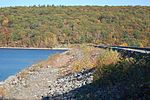Quabbin Reservoir
1938 establishments in MassachusettsBuildings and structures in Franklin County, MassachusettsBuildings and structures in Hampshire County, MassachusettsBuildings and structures in Worcester County, MassachusettsDams completed in 1938 ... and 10 more
Lakes of Franklin County, MassachusettsLakes of Hampshire County, MassachusettsLakes of Worcester County, MassachusettsProtected areas of Franklin County, MassachusettsProtected areas of Hampshire County, MassachusettsProtected areas of Worcester County, MassachusettsReservoirs in MassachusettsTributaries of the Connecticut RiverUse mdy dates from August 2021Ware, Massachusetts

The Quabbin Reservoir is the largest inland body of water in Massachusetts, and was built between 1930 and 1939. Along with the Wachusett Reservoir, it is the primary water supply for Boston, 65 miles (105 km) to the east, and 40 other cities and towns in Greater Boston. The Quabbin also supplies water to three towns west of the reservoir and acts as backup supply for three others. By 1989, it supplied water for 2.5 million people, about 40% of the state's population at the time. It has an aggregate capacity of 412 billion US gallons (1,560 GL) and an area of 38.6 square miles (99.9 km2).
Excerpt from the Wikipedia article Quabbin Reservoir (License: CC BY-SA 3.0, Authors, Images).Quabbin Reservoir
Geographical coordinates (GPS) Address Nearby Places Show on map
Geographical coordinates (GPS)
| Latitude | Longitude |
|---|---|
| N 42.359166666667 ° | E -72.3 ° |
Address
Petersham
01366
Massachusetts, United States
Open on Google Maps







